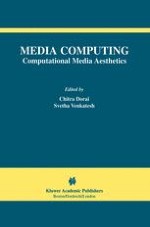2002 | OriginalPaper | Chapter
Formulating Film Tempo
The Computational Media Aesthetics Methodology in Practice
Authors : Brett Adams, Chitra Dorai, Svetha Venkatesh
Published in: Media Computing
Publisher: Springer US
Included in: Professional Book Archive
Activate our intelligent search to find suitable subject content or patents.
Select sections of text to find matching patents with Artificial Intelligence. powered by
Select sections of text to find additional relevant content using AI-assisted search. powered by
This chapter constitutes a detailed example of Computational Media Aesthetics at work. A short history of approaches to the problems posed by automatic content management in its broadest context is presented, cast in the light of their ability to obtain the much needed semantic grid with which to interpret their object. Our consideration is then further narrowed to the video medium, where we identify two common categories of solution to the problem, the kitchen sink and the brittle mapping, note their relative weaknesses, and show them to be directly attributable to the nature of the semantic grid chosen, or lack thereof. Focusing on our domain of Film, we argue that the best semantic grid for its interpretation is that within which its creators work; namely film grammar. In order to demonstrate this, we develop a measure for the extraction of a fundamental aspect of film, Tempo. From definition, to formulation, and even its exploitation resulting in the location of high-level filmic components such as dramatic occurrences, the process is guided by film grammar at every step. Example results are provided from the movie, The Matrix.
